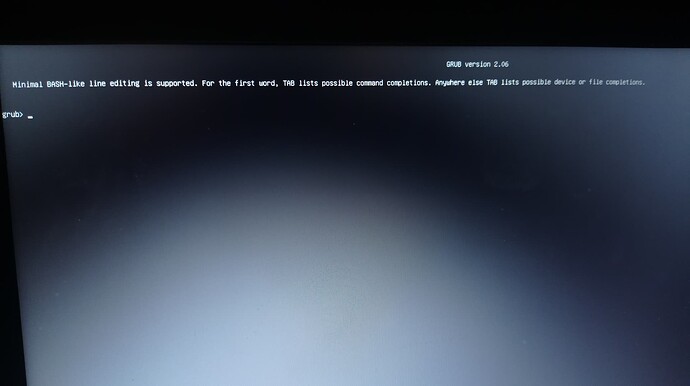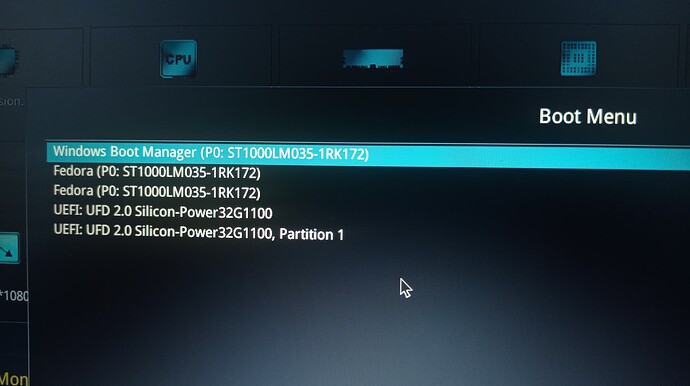sorry for the delay, I was a bit busy
output of the first command (sudo parted -l):
Model: ATA ST1000LM035-1RK1 (scsi)
Disk /dev/sda: 1000GB
Sector size (logical/physical): 512B/4096B
Partition Table: gpt
Disk Flags:
Number Start End Size File system Name Flags
1 1049kB 556MB 555MB ntfs Basic data partition hidden, diag
2 556MB 661MB 105MB fat32 EFI System Partition boot, esp
3 661MB 677MB 16.8MB Microsoft reserved partition msftres
4 677MB 228GB 227GB ntfs Basic data partition msftdata
5 228GB 1000GB 772GB ext4 endeavouros
Model: UFD 2.0 Silicon-Power32G (scsi)
Disk /dev/sdb: 32.7GB
Sector size (logical/physical): 512B/512B
Partition Table: msdos
Disk Flags:
Number Start End Size Type File system Flags
2 1931MB 2041MB 110MB primary fat16 esp
output of the second command (efibootmgr -v):
BootCurrent: 0008
Timeout: 1 seconds
BootOrder: 0003,0000,0004,0008,0009
Boot0000* Windows Boot Manager HD(2,GPT,20ebbb4f-b1a3-4a12-a5e0-c1f27c8b819f,0x109000,0x32000)/File(\EFI\MICROSOFT\BOOT\BOOTMGFW.EFI)57494e444f5753000100000088000000780000004200430044004f0042004a004500430054003d007b00390064006500610038003600320063002d0035006300640064002d0034006500370030002d0061006300630031002d006600330032006200330034003400640034003700390035007d00000061000100000010000000040000007fff0400
dp: 04 01 2a 00 02 00 00 00 00 90 10 00 00 00 00 00 00 20 03 00 00 00 00 00 4f bb eb 20 a3 b1 12 4a a5 e0 c1 f2 7c 8b 81 9f 02 02 / 04 04 46 00 5c 00 45 00 46 00 49 00 5c 00 4d 00 49 00 43 00 52 00 4f 00 53 00 4f 00 46 00 54 00 5c 00 42 00 4f 00 4f 00 54 00 5c 00 42 00 4f 00 4f 00 54 00 4d 00 47 00 46 00 57 00 2e 00 45 00 46 00 49 00 00 00 / 7f ff 04 00
data: 57 49 4e 44 4f 57 53 00 01 00 00 00 88 00 00 00 78 00 00 00 42 00 43 00 44 00 4f 00 42 00 4a 00 45 00 43 00 54 00 3d 00 7b 00 39 00 64 00 65 00 61 00 38 00 36 00 32 00 63 00 2d 00 35 00 63 00 64 00 64 00 2d 00 34 00 65 00 37 00 30 00 2d 00 61 00 63 00 63 00 31 00 2d 00 66 00 33 00 32 00 62 00 33 00 34 00 34 00 64 00 34 00 37 00 39 00 35 00 7d 00 00 00 61 00 01 00 00 00 10 00 00 00 04 00 00 00 7f ff 04 00
Boot0003* Fedora HD(2,GPT,20ebbb4f-b1a3-4a12-a5e0-c1f27c8b819f,0x109000,0x32000)/File(\EFI\FEDORA\SHIMX64.EFI)
dp: 04 01 2a 00 02 00 00 00 00 90 10 00 00 00 00 00 00 20 03 00 00 00 00 00 4f bb eb 20 a3 b1 12 4a a5 e0 c1 f2 7c 8b 81 9f 02 02 / 04 04 34 00 5c 00 45 00 46 00 49 00 5c 00 46 00 45 00 44 00 4f 00 52 00 41 00 5c 00 53 00 48 00 49 00 4d 00 58 00 36 00 34 00 2e 00 45 00 46 00 49 00 00 00 / 7f ff 04 00
Boot0004* Fedora HD(2,GPT,20ebbb4f-b1a3-4a12-a5e0-c1f27c8b819f,0x109000,0x32000)/File(\EFI\FEDORA\SHIM.EFI)0000424f
dp: 04 01 2a 00 02 00 00 00 00 90 10 00 00 00 00 00 00 20 03 00 00 00 00 00 4f bb eb 20 a3 b1 12 4a a5 e0 c1 f2 7c 8b 81 9f 02 02 / 04 04 2e 00 5c 00 45 00 46 00 49 00 5c 00 46 00 45 00 44 00 4f 00 52 00 41 00 5c 00 53 00 48 00 49 00 4d 00 2e 00 45 00 46 00 49 00 00 00 / 7f ff 04 00
data: 00 00 42 4f
Boot0008* UEFI: UFD 2.0 Silicon-Power32G1100 PciRoot(0x0)/Pci(0x12,0x0)/USB(0,0)/USB(0,0)/CDROM(1,0x398c00,0xd2a6)0000424f
dp: 02 01 0c 00 d0 41 03 0a 00 00 00 00 / 01 01 06 00 00 12 / 03 05 06 00 00 00 / 03 05 06 00 00 00 / 04 02 18 00 01 00 00 00 00 8c 39 00 00 00 00 00 a6 d2 00 00 00 00 00 00 / 7f ff 04 00
data: 00 00 42 4f
Boot0009* UEFI: UFD 2.0 Silicon-Power32G1100, Partition 1 PciRoot(0x0)/Pci(0x12,0x0)/USB(0,0)/USB(0,0)/HD(1,MBR,0x5ab6cd03,0x398c00,0x34800)0000424f
dp: 02 01 0c 00 d0 41 03 0a 00 00 00 00 / 01 01 06 00 00 12 / 03 05 06 00 00 00 / 03 05 06 00 00 00 / 04 01 2a 00 01 00 00 00 00 8c 39 00 00 00 00 00 00 48 03 00 00 00 00 00 03 cd b6 5a 00 00 00 00 00 00 00 00 00 00 00 00 01 01 / 7f ff 04 00
data: 00 00 42 4f
bonus: a photo of my BIOS boot menu, which still has Fedora options, even though I did erase Fedora’s partition through GParted:

